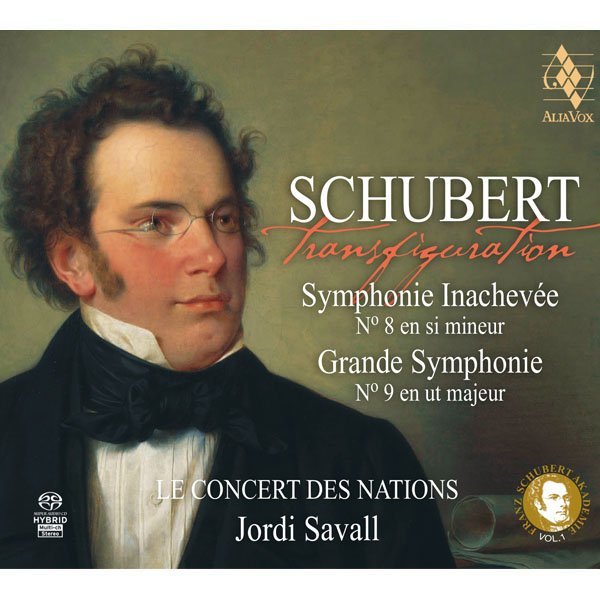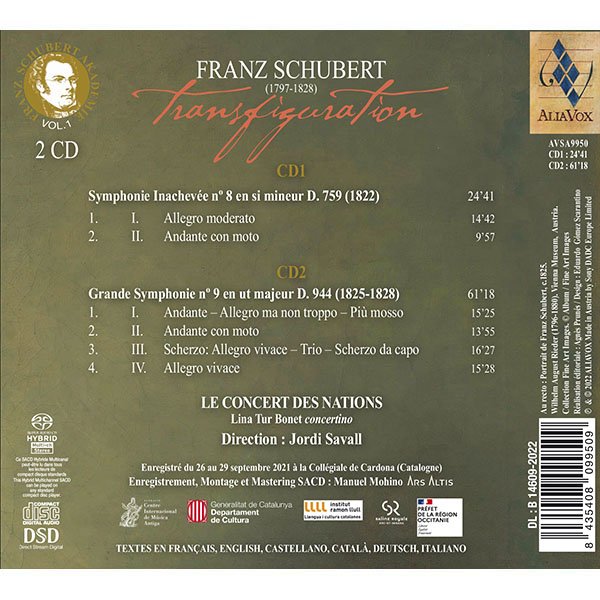FRANZ SCHUBERT
Transfiguració
Jordi Savall, Le Concert des Nations
17,99€
ALIA VOX
AVSA9950
FRANZ SCHUBERT
(1797-1828)
Transfiguration
Unfinished Symphony in B minor
& Great Symphony in C major
CD1
Symphonie Inachevée nº 8 en Si mineur 24’41
D. 759 (1822)
I. Allegro moderato 14’42
II. Andante con moto 9’57
CD2
Grande Symphonie nº 9 en ut majeur 61’18
D. 944 (1825-1828)
I. Andante – Allegro ma non troppo – Più mosso 15’25
II. Andante con moto 13’55
III. Scherzo: Allegro vivace – Trio – Scherzo da capo 16’27
IV. Allegro vivace 15’28
Enregistré du 26 au 29 septembre 2021 à la Collégiale de Cardona (Catalogne)
Enregistrement, Montage et Mastering SACD : Manuel Mohino ARS ALTIS
–
“When I wished to sing of love,
it turned to pain.
And when I wished to sing of pain,
it turned to love.”
Franz Schubert, 1822
Mein Traum (“My dream”)
Without fear of being indiscreet, we can now admit that we were thinking of devoting our energies to Schubert’s Symphonies 8 and 9 immediately after finishing our cycle of the complete Beethoven symphonies, which, after a year’s delay as a result of Covid, concluded with the concert on 15th December, 2021, at Barcelona’s Gran Teatre del Liceu.
Having said that, this idea of a symphonic cycle with Le Concert des Nations focusing on the principal composers of the 19th century began much earlier, in 1993 in fact, when we were preparing Beethoven’s Third and Juan Crisóstomo de Arriaga’s Great Symphony for the recording we made in January, 1994. Unfortunately, lack of funding on the part of our recording label AUVIDIS forced us to shelve the project. This was one of the reasons why we decided to create our own recording label ALIA VOX in 1997.
+ information in the CD booklet
JORDI SAVALL
Stainz-Fontfroide, July, 2022
Translated by Jacqueline Minett
SELECT BIBLIOGRAPHY
– MASSIN, Brigitte: Franz Schubert. Paris, Fayard, 1977.
– HANDMAN, Dorel: “Schubert” in Histoire de la musique, vol. 2 Encyclopédie de la Pléiade. Paris, Gallimard, 1963.
– VV.AA: La Revue Musicale, “Franz Schubert et la Symphonie”, Nos. 355-356-357, Richard-Masse, Paris, 1982.
– TUBEUF, André: Schubert: L’ami Franz, Arles, Actes Sud, 2021.
Critics
”
El refinament qualitatiu de Transfiguration ens amplia els horitzons de la música.
SONOGRAMA. Núria Serra. Novembre 2022.
”
El resultado de Savall es sorprendente porque Le Concert des Nations consigue crear un bello contraste entre la calidez de las cuerdas de tripa y el gran poder y fuerza que tienen los metales naturales, así como la dulzura de las maderas, sin olvidar la precisa percusión.
MELÓMANO DIGITAL. Angel Villagrasa Pérez. 18/01/23
”
Un álbum excelente, que los amantes de un Schubert en interpretación históricamente informada no deberían dejar pasar.
SCHERZO. Rafael Ortega Basagoiti. Marzo 2023
”
Seine Rigorosität in der Umsetzung der ständigen dynamischen Kontraste und der ganz speziellen Klangregie Schuberts aber setzt in der „Unvollendeten“ ein Bedrohungspotenzial frei, wie man es in einer solchen Intensität wohl noch nicht gehört hat.
RONDO MAGAZIN. Attila Csampai. 15/10/2022
”
Superbe travail d’orchestre, prise de son analytique à la hauteur de l’enjeu : de la part de Savall, qui a fêté l’année dernière ses quatre-vingt printemps avec l'Académie Schubert 2021 dont résulte cet album, on peut voir dans cet enregistrement une sorte d’aboutissement personnel.
MUSIKZEN. François Lafon. 6/10/2022
”
When it comes to Schubert, it’s been a long time since I’ve heard such an exciting interpretation as that of the 9th Symphony under the electrifying direction of Jordi Savall. It’s high-pitched, and the heavy pathos that makes this work so dangerous is reduced to an acceptable level here, even though Savall approaches the Ninth quite sonorously and with many effects.
PIZZICATO. Alain Steffen. 09/2022
”
For a persuasive period-instrument recording of these two great works that nevertheless takes nothing for granted, this may well now be the ideal choice.
GRAMOPHONE. David Threasher. 09/2022
”
"Transfiguració", el nou disc de Jordi Saval dedicat a dues simfonies de Franz Schubert.Un àlbum doble dedicat a la coneguda com la Simfonia "Inacabada" i la Simfonia n. 9 en Do, "La gran" de Franz Schubert. Dues obres que interpreten Le Concert des nations, dirigit per Jordi Savall. L'àlbum es va enregistrar el setembre del 2021 a la Col·legiata de Cardona i l'ha editat el segell Alia Vox.
CATALUNYA RADIO 24.10.2022
”
Jordi Savall n’a pas fini de nous surprendre. Après des décennies à labourer patiemment le répertoire de la Renaissance à Mozart, il nous est arrivé récemment avec une bouleversante intégrale des symphonies de Beethoven, réalisée avec son Concert des Nations enrichi de jeunes stagiaires aussi virtuoses que passionnés. Dernier fruit de cette collaboration : les deux dernières symphonies de Schubert. On en ressort difficilement indemne, tellement on a l’impression de redécouvrir ces partitions tant de fois ressassées. Cela sent le grand air des montagnes. Une authentique bouffée d’air frais.
LA PRESSE. Cinq incontournables en Classique.Emmanuel Bernier. 21 décembre 2022
”
Al igual que en las grabaciones de Beethoven, Savall continúa en la línea de una interpretación que, valiéndose de los instrumentos originales y del estudio en profundidad de las obras, pone en valor este repertorio romántico, ofreciéndonos una versión más íntima y cercana a la época, respetando y revalorizando el equilibrio entre secciones, timbres y dinámicas de las obras.
RITMO. Raquel Serneguet. Noviembre 2023








Share